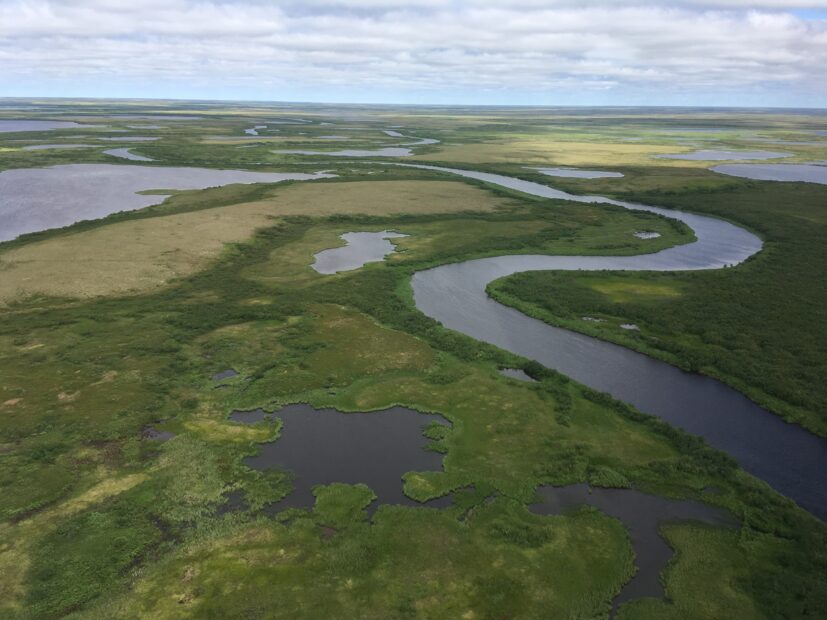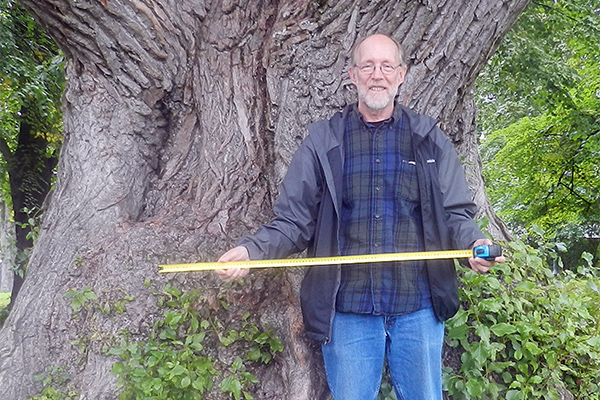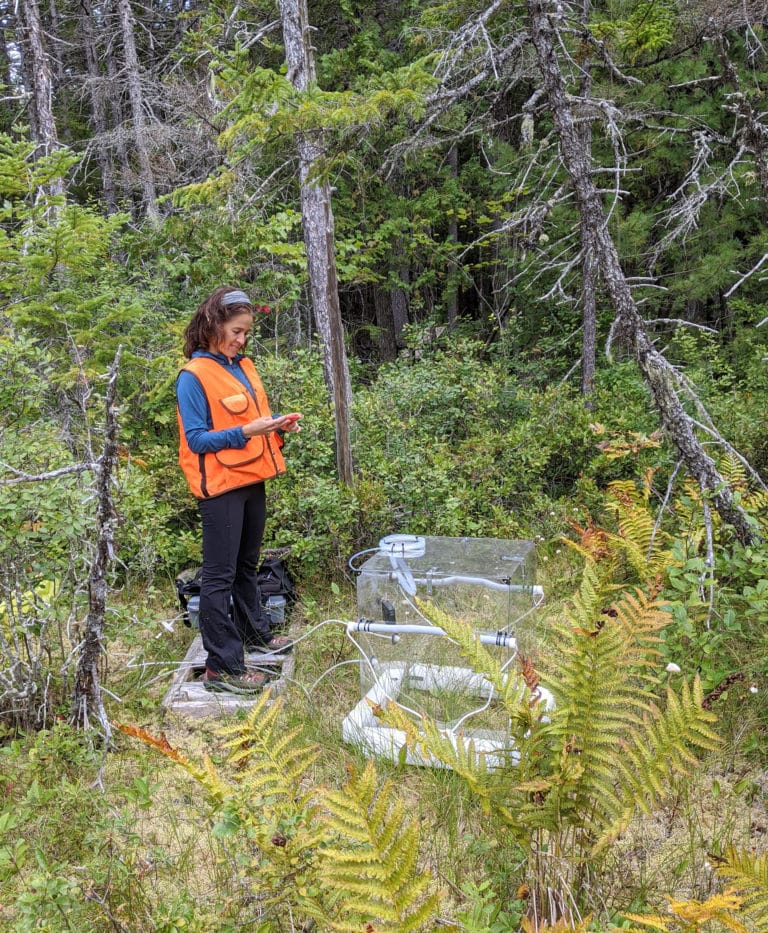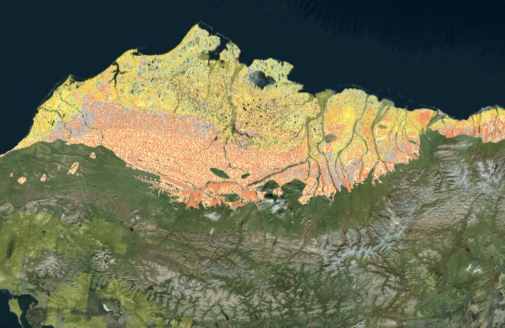Fund for Climate Solutions awards largest cohort to date
Seven projects aim to push boundaries across all areas of Woodwell’s work

Yukon-Kuskokwim Delta, Alaska / photo by Anya Suslova
The Fund for Climate Solutions is a competitive, internal granting mechanism that supports early-stage and high-risk, high-reward research with breakthrough potential. New awards are made twice each year. The latest cohort comprises seven highly-collaborative projects and more than $650,000 in funding to support innovative extensions of ongoing research with near-term policy relevance.

Dr. Rich Birdsey measuring a large tree. / photo courtesy of Rich Birdsey
Preserving and increasing carbon stocks of large trees on federal lands
Project Lead: Dr. Richard Birdsey
There is an urgent need to identify large, older trees and mature forest stands on U.S. public lands that could be protected from harvest to maintain their carbon stocks and growth potential. Building on preliminary work with the Natural Resources Defense Council, and working in collaboration with Wild Heritage, Woodwell Climate scientists will develop a quantitative method for identifying mature forests and apply this to U.S. National Forests in order to clarify thresholds for protection from logging and estimate the likely carbon storage resulting from protection. This project addresses key policies for federal land management contained in two recent Executive Orders, and has the potential to contribute significantly to maintaining present and future carbon stocks on public lands and achieving the nation’s goal of net-zero greenhouse gas emissions by 2050.
The importance of protected areas and Indigenous lands for Amazon climate
Project Lead: Dr. Michael T. Coe
Amazon forests take up water from the soil and evaporate it to the atmosphere, cooling the land surface and sustaining up to half of regional rainfall. This forest function is critical for biodiversity, carbon cycling, and food and energy production, but it is threatened by deforestation and its integration into climate policy has lagged due to knowledge gaps. In this project, we will quantify the climatic importance of forests in Indigenous territories, protected natural areas, and undesignated lands, which together account for roughly half the area of standing Amazon forest and a third of deforestation. This new understanding will be key to the development of targeted conservation strategies and stronger policies and land-use planning for protection of forests and their climate benefits.
Quantifying carbon fluxes in wetland ecosystems from tropical South America to temperate New England
Project Lead: Dr. Marcia Macedo
Wetland ecosystems—whether natural, man-made, or restored—play a significant role in carbon cycling. Whether they are net sinks or sources of carbon to the atmosphere depends on local hydrology, vegetation, and land management in a changing climate. Woodwell scientists have studied these processes across a wide range of ecosystems, including small reservoirs in the Amazon, forests and bogs in Maine, and active or newly restored cranberry bogs in Massachusetts. However, traditional techniques for measuring carbon fluxes can be limiting in ecologically complex and/or rapidly changing environments. The purchase of a portable gas analyzer will enable real-time measurement of greenhouse gas fluxes at fine scale, adding a new dimension to ongoing work in these important environments.


Left: Dr. Marcia field testing a gas collection chamber at Howland Forest in Maine. / photo by Kathleen Savage
Right: Soil core taken at Pariah Dog Farm. / photo by Jonathan Sanderman
Rapid soil health assessment
Project Lead: Dr. Jonathan Sanderman
In order for food producers around the globe to improve soil health and increase soil carbon storage, they must first be able to measure it reliably and inexpensively. Previous work supported by the Fund for Climate Solutions has demonstrated that low-cost, handheld, infrared sensors connected to smartphones have the potential to meet the need for soil carbon monitoring. This project will expand the scope of ongoing work with Africa-based Innovative Solutions for Decision Agriculture (iSDA) to assess the effectiveness of this technology for measuring overall soil fertility and soil health status. This work has the potential to enable scientific advances and improved land management decisions that could help close the agricultural yield gap in some of the world’s poorest regions.
Climate change and global security
Project Lead: Dr. Alex Naegele
Climate change has been identified as a critical national security issue—as a threat multiplier that exacerbates existing societal stressors and regional instabilities. However, the inclusion of granular climate impacts in security strategy is not yet widely practiced. In collaboration with the Center for Climate & Security, Woodwell Climate’s Risk Program aims to provide actionable climate intelligence that can be used to directly inform security policy. In this project, two case studies on countries with strong regional influence and mounting climate vulnerabilities (e.g. Indonesia, Iran, Turkey, and South Africa) will synthesize climate risk assessments and security insight to develop a comprehensive climate security analysis. This research will be accompanied by U.S. policy recommendations to address security risks, and it will be shared with policymakers and leaders in the security community to normalize this essential approach to climate security.
Gaining new insights into drivers of carbon emissions from Alaska permafrost by integrating radiocarbon, VLF-ERT, and soil respiration monitoring
Project Lead: Dr. Jennifer Watts
Thawing high latitude permafrost is expected to become a significant source of carbon dioxide and methane emissions this century. Accurately projecting future emissions requires not only measuring overall carbon release and uptake rates, but also understanding the biological and ecological processes at work. This project addresses two key knowledge gaps: differentiating the contributions of soil microbes and plant respiration to carbon emissions under differing environmental conditions, and understanding the impact of fire on subsequent carbon loss from soils. Specialized, year-round gas monitoring at burned and unburned sites near Hess Creek, AK, along with carbon dating and permafrost decay mapping using Very Low Frequency Electrical Resistivity Tomography (VLF-ERT), will provide proof of concept for a novel technique that can be applied across the Arctic to address these knowledge gaps and improve models and projections of permafrost thaw carbon emissions.
Tracking global contaminants in ecosystems on the frontline of permafrost thaw
Project Lead: Dr. Scott Zolkos
Rapid permafrost thaw is creating hazardous conditions for northern communities, as thawing and collapsing ground threatens infrastructure and Indigenous ways of living. It also poses a severe risk to human and ecosystem health, because toxic mercury (Hg) and poly- and perfluoroalkyl substances (PFAS) have accumulated to high levels within permafrost region ecosystems and are now being released into drinking water, and bioaccumulating in fish and other organisms that are essential to northern diets, health, and cultures. Despite the risk, the magnitude of Hg and PFAS release associated with permafrost thaw is largely unknown. This project will leverage the scientific infrastructure and community outreach efforts of two flagship Woodwell Climate projects—Permafrost Pathways and Science on the Fly—to establish the first observatory for tracking contaminants in waters of local importance within permafrost regions.







